23.12.2019
KONNECT and GSAT-30 are readied for Arianespace’s first Ariane 5 mission of 2020
The two satellite passengers for Arianespace’s year-opening Ariane 5 mission of 2020 are undergoing checkout at the Spaceport in preparation for their flight to geostationary transfer orbit.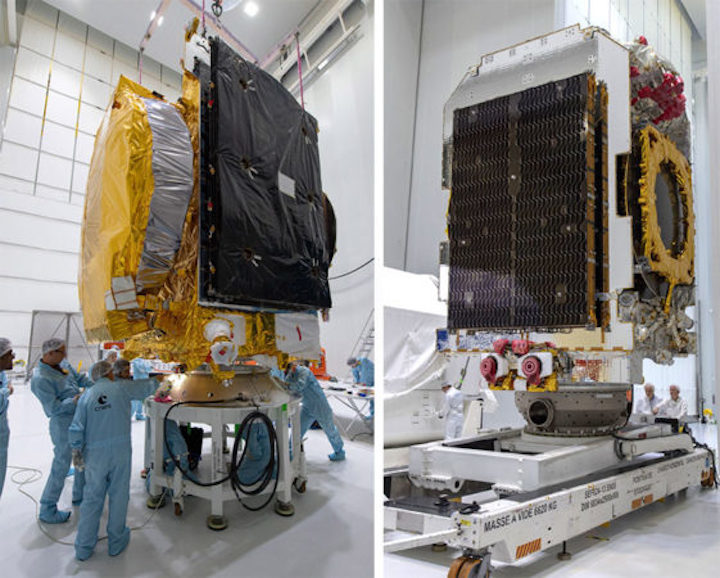
Riding in the upper position of Ariane 5’s dual-payload dispenser system will be KONNECT, a new-generation high-throughput satellite that will deliver services across Europe and Africa – which was produced by Thales Alenia Space based on its Spacebus NEO platform.
India’s GSAT-30 – which was designed, assembled and integrated by the Indian Space Research Organization (ISRO) – will be the second passenger deployed during the mission. Built using an I-3K satellite platform, it is to provide high-quality television, telecommunications and broadcasting services.
Both spacecraft currently are undergoing their preparation activity in the Spaceport’s S5 payload processing facility.
The launch of KONNECT and GSAT-30 is designated Flight VA251 in Arianespace’s mission numbering system – signifying the 251st liftoff of an Ariane-series vehicle from Europe’s Spaceport in French Guiana.
+++
Preparations for Arianespace’s year-opening Ariane 5 mission enter the payload integration phase
Payload integration is underway for Arianespace’s first mission of 2020 – designated Flight VA251 – which will orbit satellites at the service of two long-time partners using an Ariane 5 launch vehicle.
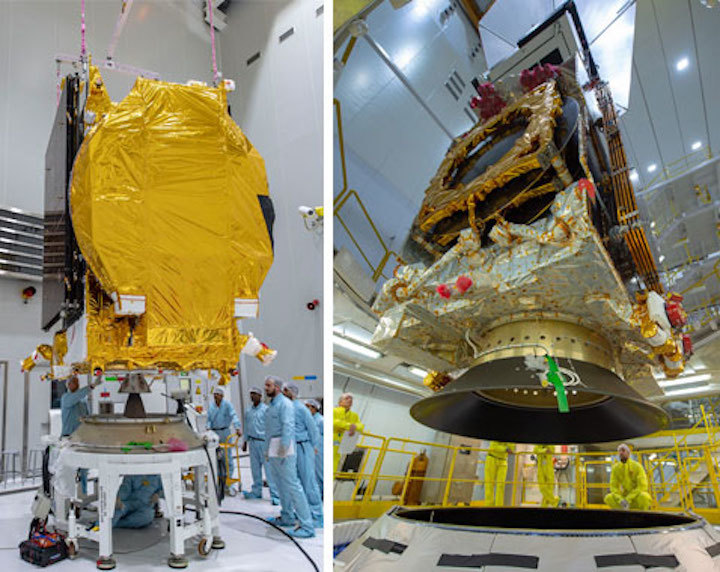
Recent activity at the Spaceport in French Guiana included initial steps in creating the dual-payload configuration, with Eutelsat’s KONNECT satellite riding in the upper position. This involved installing the spacecraft atop Ariane 5’s SYLDA dispenser system during activity inside the launcher’s Final Assembly Building.
KONNECT will now be encapsulated by Ariane 5’s protective fairing, completing the payload configuration’s upper portion and readying it for positioning over co-passenger GSAT-30 once this spacecraft from the Indian Space Research Organization (ISRO) is installed atop the heavy-lift launcher.
One launcher, two satellites
Following Ariane 5’s liftoff from the Spaceport on January 16, KONNECT will be released into geostationary transfer orbit (GTO) first, followed by the separation of SYLDA – enabling GSAT-30’s subsequent deployment to GTO.
KONNECT – which was produced by Thales Alenia Space – is a new-generation high-throughput satellite that will deliver services across Europe and Africa. Featuring all-electric propulsion and configured for operation in Ka-band, it is the first to use Thales Alenia Space’s Spacebus NEO platform developed under the Neosat Partnership Project conducted by the European and French space agencies (ESA and CNES).
ISRO’s GSAT-30 was built using an I-3K satellite platform, and is to provide high-quality television, telecommunications and broadcasting services. It will have a liftoff mass of some 3,450 kg. and is to ensure continuity of service for India’s INSAT 4A, positioned at 83 deg. East longitude.
Quelle: arianespace
----
Update: 6.01.2020
.
India to launch GSAT-30 communication satellite on January 17
The Indian Space Research Organisation (ISRO) is ready to launch its GSAT-30, a heavy communication satellite on January 17. The launch will take place at the Kourou space centre in French Guiana. GSAT-30 will lunch on board an Ariane-5 rocket, which belongs to the European Space Agency (Arianespace).
To recall, Arianespace launched ISRO’s GSAT-31 on February 6 last year. GSAT-31 has a 1-2K bus structure to provide communication services from a geostationary orbit in Ku-band for 15 years.
GSAT-30 is ISRO’s first satellite to launch in 2020. It will augment the capacity to provide communication links to state-run and private service providers.
ISRO currently has plans to launch 25 satellites including the Aditya-L1 satellite, which will be inserted in a halo orbit around the Lagrangian point (L1), about 1.5 million km from the earth. The Aditya-L1 satellite will study the solar corona, which has more than a million degree Kelvin temperature. It will also study the Chromosphere and particle flux emanating from the sun.
Other launches of the year include SSLV (Small Satellite Launch Vehicle), which will place smaller satellites in the earth’s lower orbit, GSLV, GSAT-20 satellite, NavIC, Indian Data Relay Satellite System and Xposat.
To recall, last year ISRO launched six launch vehicles and seven satellite missions. It also celebrated the 50th launch of the Polar Satellite Launch Vehicle (PSLV).
Quelle: The Indian Express
----
Update: 11.01.2020
.
GSAT-30 is installed on Ariane 5 for Arianespace’s first mission of 2020
Final payload integration has begun for Arianespace’s year-opening mission on January 16, with GSAT-30 now installed atop its Ariane 5 launcher at the Spaceport in French Guiana.
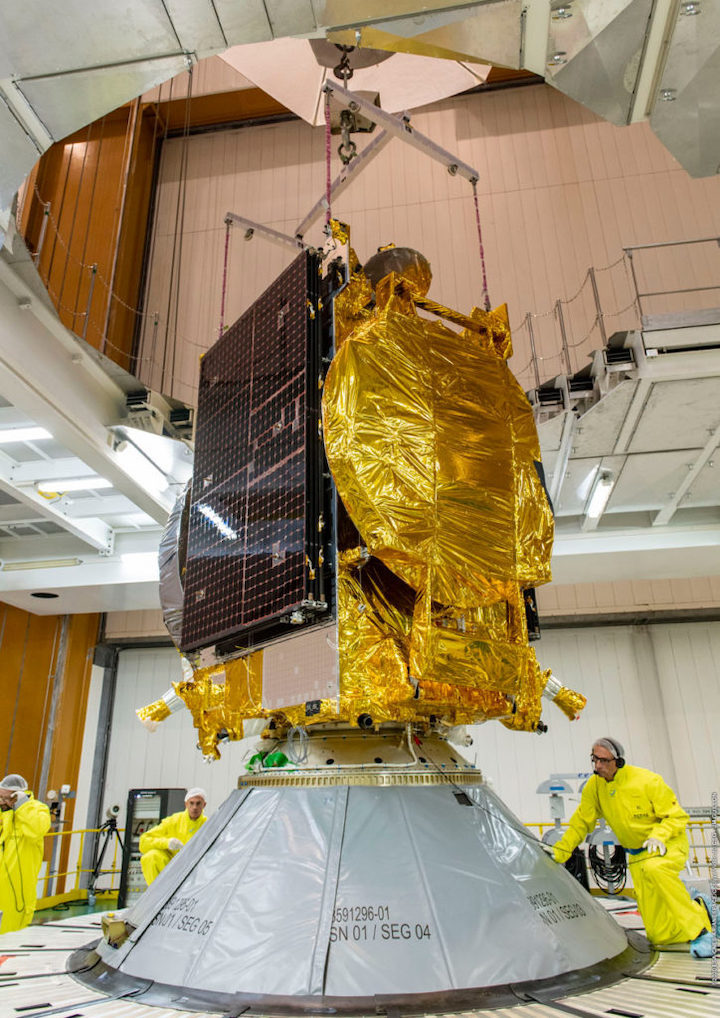
GSAT-30 is lowered for installed atop the Ariane 5’s core stage section during activity at the Spaceport in French Guiana.
This satellite was positioned on the assembled Ariane 5’s core cryogenic stage during activity inside the Spaceport’s launch vehicle Final Assembly Building – placing it as the mission’s lower passenger, to be released second in the flight sequence after its co-passenger, EUTELSAT KONNECT.
GSAT-30 was produced by the Indian Space Research Organization (ISRO) using an I-3K platform, and is to provide high-quality television, telecommunications and broadcasting services. It will have a liftoff mass of some 3,357 kg. and is to ensure continuity of service for India’s INSAT 4A, positioned at 83 deg. East longitude.
Connecting EUTELSAT KONNECT
With GSAT-30 affixed to the Ariane 5, all is clear for EUTELSAT KONNECT’s integration over it as part of the launcher’s “upper composite” – which also includes the SYLDA dispenser system and protective payload fairing as a combined unit.
EUTELSAT KONNECT is a new-generation high-throughput satellite that will deliver services across Europe and Africa. Produced by Thales Alenia Space, it is the first to use the company’s Spacebus NEO platform developed under the Neosat Partnership Project conducted by the European and French space agencies (ESA and CNES). EUTELSAT KONNECT will weight approximately 3,620 kg. at liftoff and is to operate from an orbital slot at 13 deg. East.
Next week’s mission is designated Flight VA251 in Arianespace’s launcher family numbering system, signifying the 251st launch of an Ariane-series vehicle.
Arianespace has identified a total of 12 flight opportunities from French Guiana this year using its full launcher family – which also includes Soyuz and Vega.
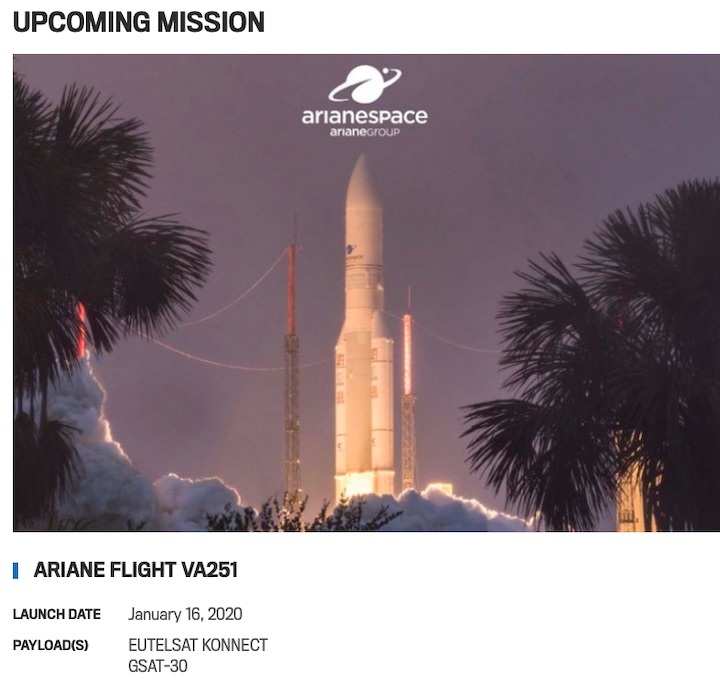
Launch window for Flight VA251:
| French Guiana | Washington, D.C. | UTC | Paris | New Delhi |
| Between 6:05 p.m. and 8:00 p.m. on Jan. 16 |
Between 4:05 p.m. and 6:00 p.m. on Jan. 16 |
Between 21:05 and 23:00 on Jan. 16 |
Between 10:05 p.m. and 12:00 a.m. on Jan. 16/17 |
Between 2:35 a.m. and 4:30 a.m. on Jan. 17 |
----
Update: 16.01.2020
.
Ariane 5 is cleared for Arianespace’s year-opening launch with EUTELSAT KONNECT and GSAT-30
Arianespace’s first mission of 2020 has been authorized for liftoff from the Spaceport in French Guiana, with this “green light” provided at the conclusion of today’s launch readiness review for an Ariane 5 flight with two telecommunications satellite passengers.

Flight VA251’s “upper composite” – composed of EUTELSAT KONNECT, the SYLDA dispenser system and Ariane 5’s protective payload fairing – is lowered over GSAT-30 to complete launcher build-up.
The approval follows integration of Ariane 5’s dual payload, which was completed inside the Spaceport’s launch vehicle Final Assembly Building.
Liftoff of the year-opening mission – designated Flight VA251 in Arianespace’s numbering system – is set for January 16 during a launch window that opens at 6:05 p.m. local time in French Guiana. The two passengers are to be deployed into geostationary transfer orbit during a mission lasting approximately 38 minutes.
Today’s authorization clears Ariane 5 for its roll-out tomorrow from the Spaceport’s Final Assembly Building to the ELA-3 launch zone, where it will be readied for Thursday’s liftoff.
Another dual-passenger deployment for Ariane 5
Encapsulated in the protective fairing, EUTELSAT KONNECT is mated atop Ariane 5’s SYLDA dual-payload dispenser system and positioned as the launch vehicle’s upper passenger. To be deployed first during the flight sequence, it is a new-generation high-throughput satellite that will deliver services across Europe and Africa.
Produced by Thales Alenia Space, EUTELSAT KONNECT is the first to use the company’s Spacebus NEO platform developed under the Neosat Partnership Project conducted by the European and French space agencies (ESA and CNES). The spacecraft will weigh approximately 3,620 kg. at liftoff.
Located below EUTELSAT KONNECT in the launcher payload configuration is the lower passenger, GSAT-30, installed atop the heavy-lift vehicle’s core stage.
Produced by the Indian Space Research Organization (ISRO) using an I-3K platform, GSAT-30 is to provide high-quality television, telecommunications and broadcasting services. It has a calculated liftoff mass of 3,357 kg. and is to ensure continuity of service for India’s INSAT 4A, positioned at 83 deg. East longitude.
The overall lift performance for Ariane 5 on Flight VA251 is estimated at 7,888 kg. – which includes the mass of its two satellite passengers and the payload integration hardware.
+++
Ariane 5 reaches the launch zone for tomorrow’s dual-satellite mission
Arianespace has delivered another Ariane 5 to the launch zone at Europe’s Spaceport in French Guiana, positioning the vehicle for liftoff on January 16 with two satellite passengers on board: EUTELSAT KONNECT and GSAT-30.

The Ariane 5 nears completion of its transfer from the Final Assembly Building to the ELA-3 launch zone.
Riding atop a mobile launch table, Ariane 5 was transferred to the ELA-3 launch zone from the Spaceport’s Final Assembly Building – where its two passengers had been integrated as part of pre-flight preparations.
With the rollout completed, the final countdown will begin for Thursday’s liftoff at the start of a 1-hour, 55-minute launch window scheduled to open at 6:05 p.m. local time in French Guiana.
Sending satellites to GTO
For this 251st launch of an Ariane-series vehicle – designated Flight VA251 in Arianespace’s numbering system – the payload lift performance to geostationary transfer orbit (GTO) is approximately 7,888 kg. This combined total factors in EUTELSAT KONNECT and GSAT-30, plus the dual-passenger dispenser system and satellite integration hardware.
EUTELSAT KONNECT – which was produced by Thales Alenia Space for Eutelsat – is riding in the upper position of Ariane 5’s payload arrangement, to be released first in the flight sequence at 27 minutes following liftoff.
GSAT-30 was designed and manufactured by the Indian Space Research Organization (ISRO), and will be deployed from Ariane 5’s lower passenger position 38 minutes into the flight – completing the mission.
Launch window for Flight VA251:
| French Guiana | Washington, D.C. | UTC | Paris | New Delhi |
| Between 6:05 p.m. and 8:00 p.m. on Jan. 16 |
Between 4:05 p.m. and 6:00 p.m. on Jan. 16 |
Between 21:05 and 23:00 on Jan. 16 |
Between 10:05 p.m. and 12:00 a.m. on Jan. 16/17 |
Between 2:35 a.m. and 4:30 a.m. on Jan. 17 |
Quelle: arianespace
+++
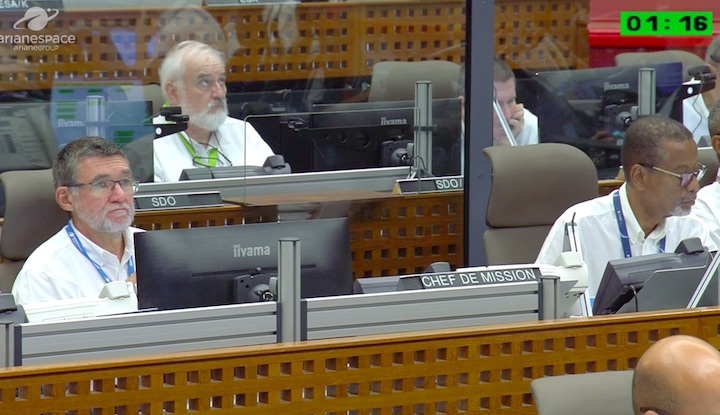
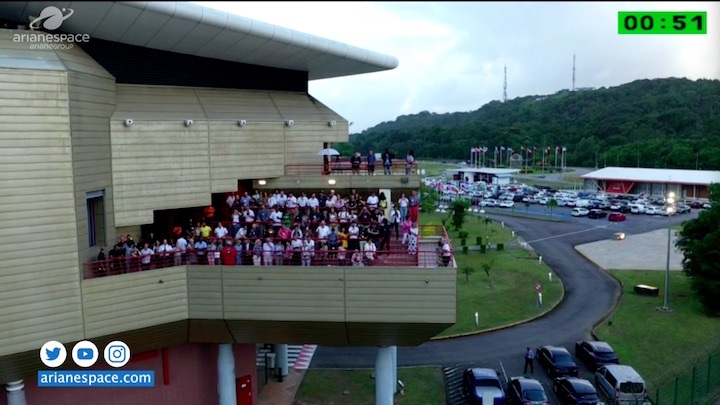
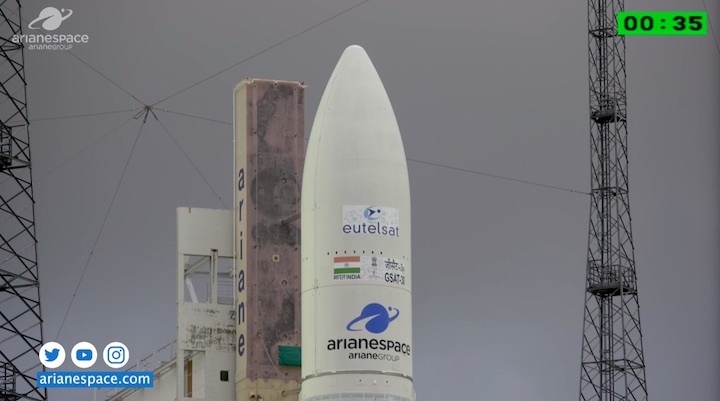
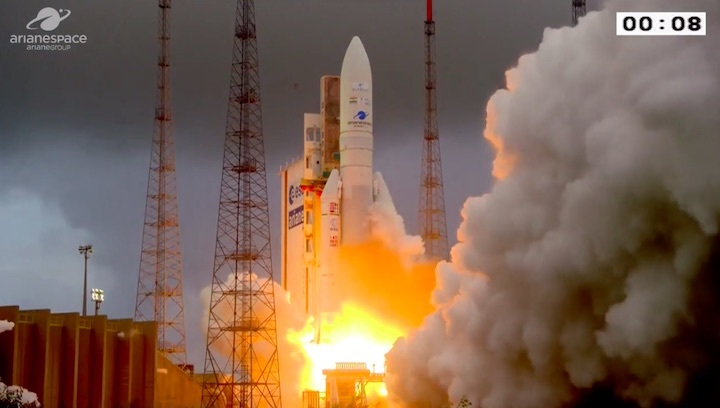
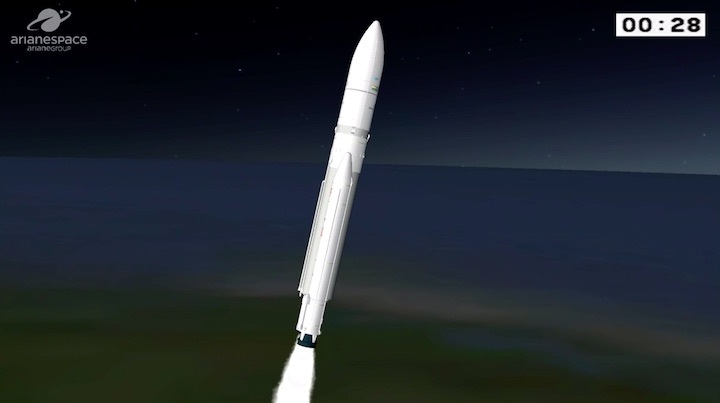
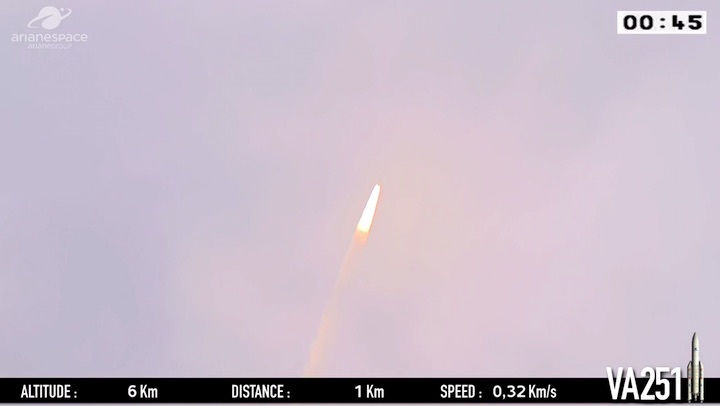
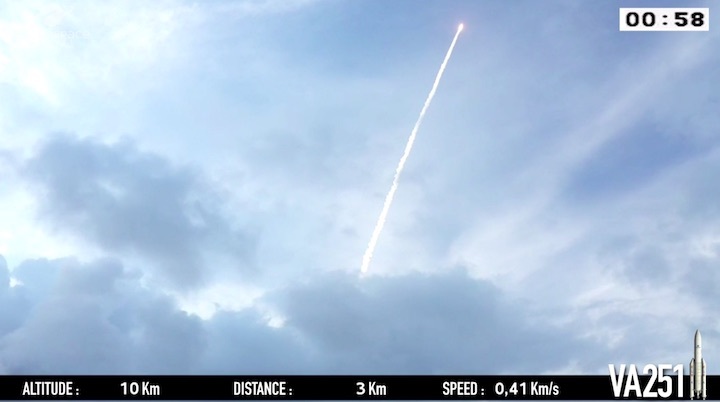
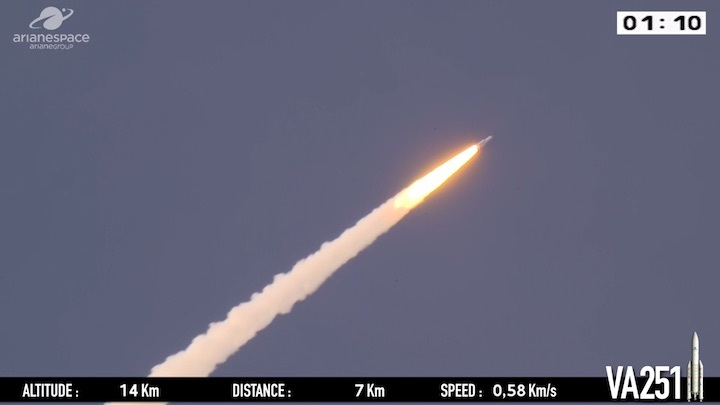
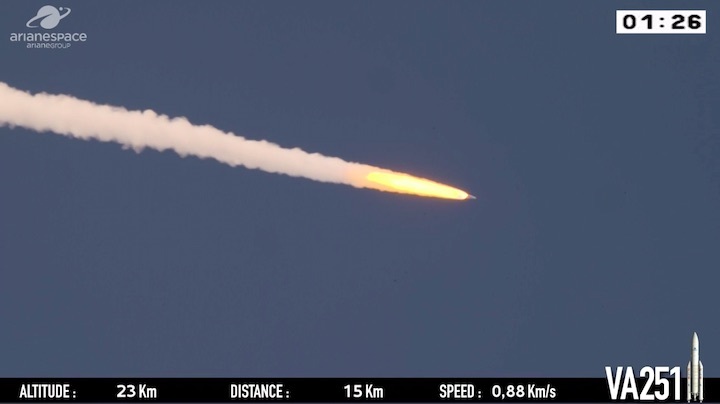
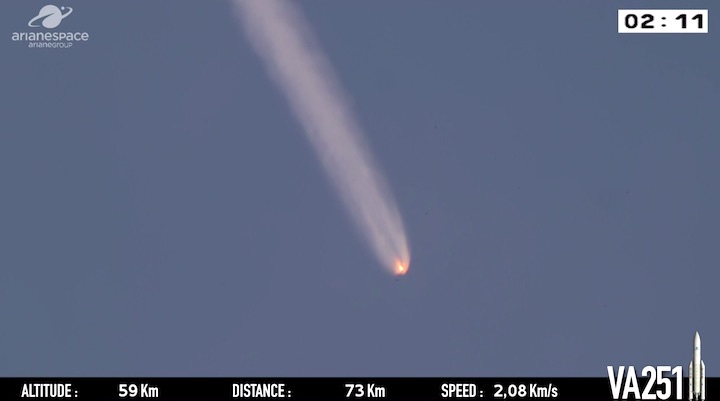

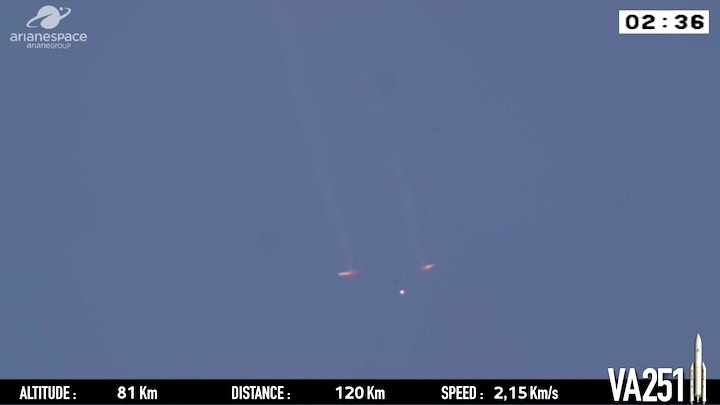
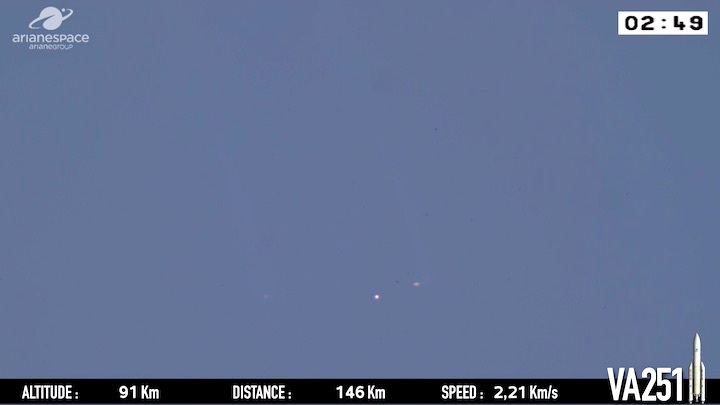
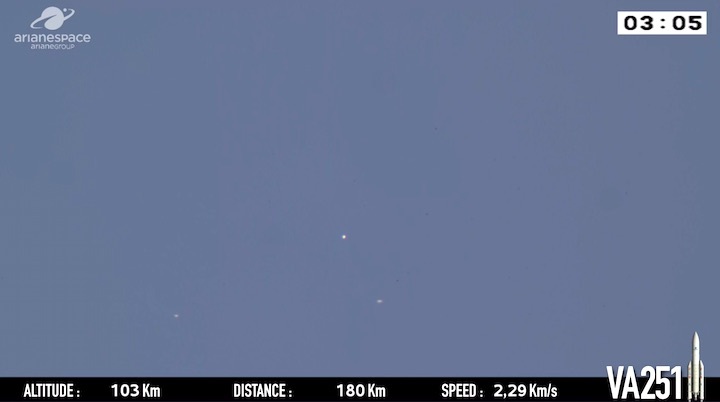
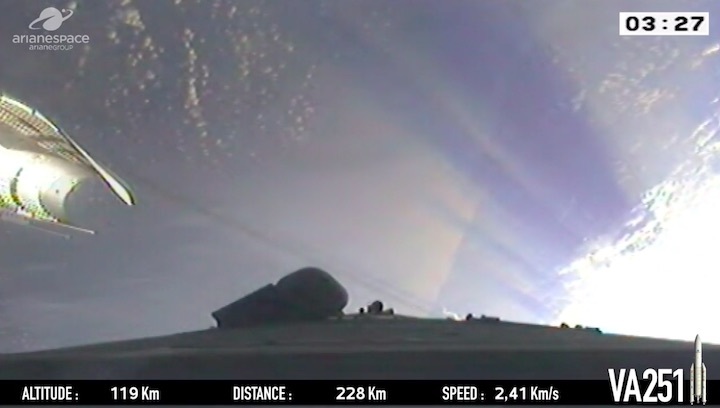
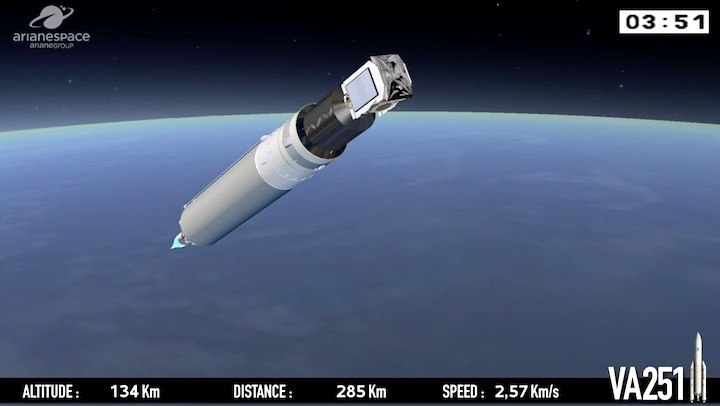
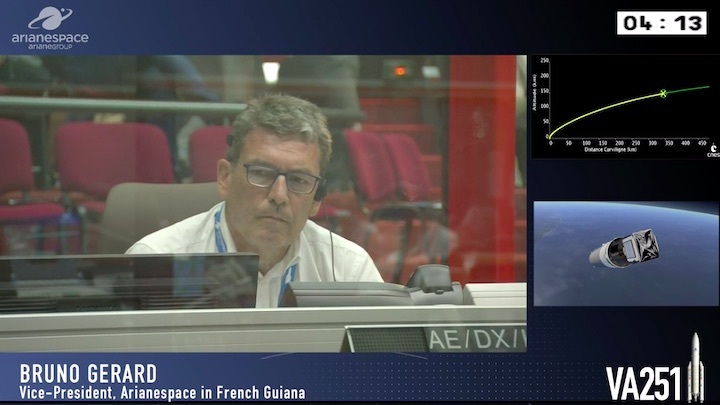
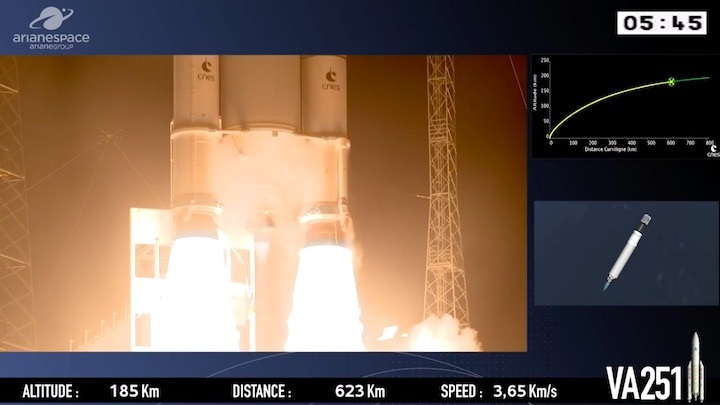
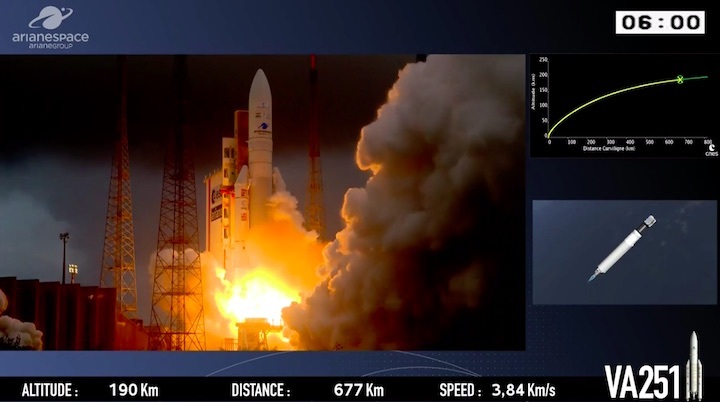
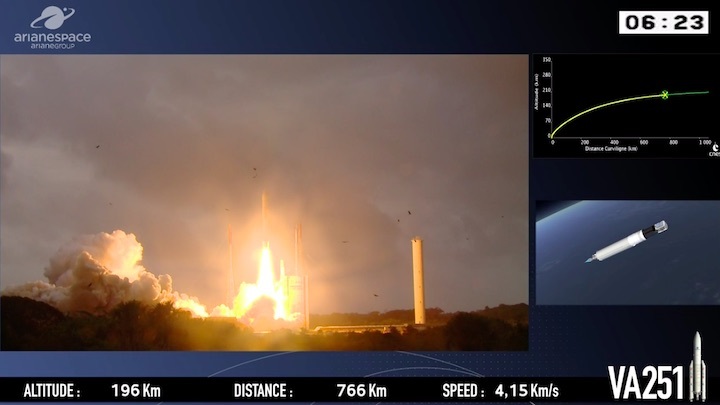
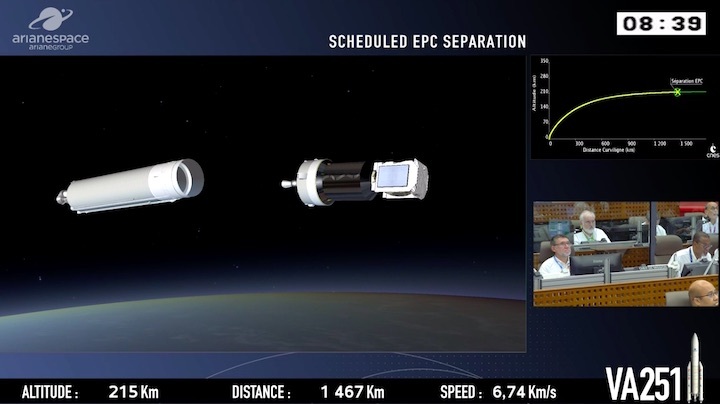
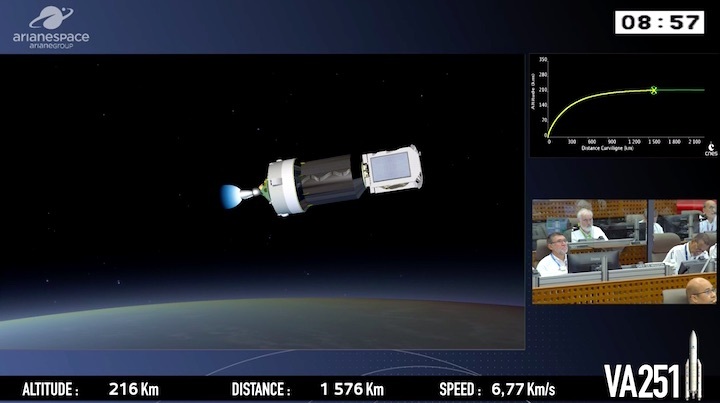
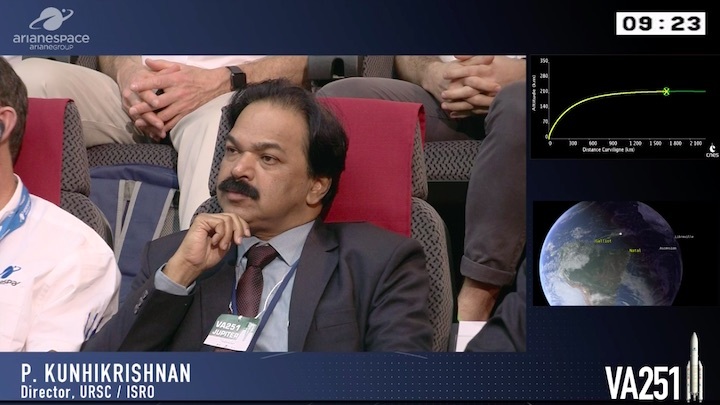
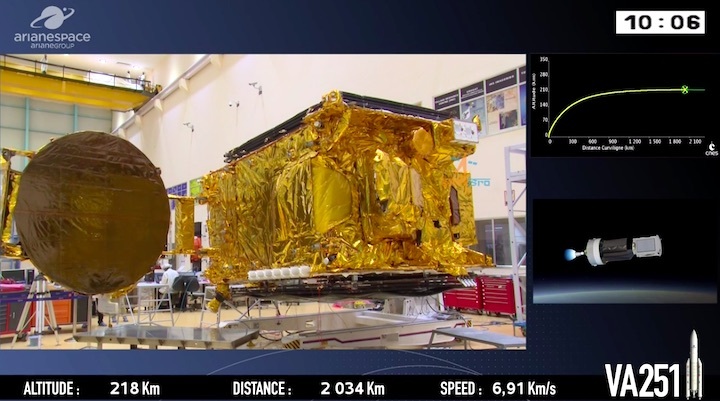
Quelle: arianespace

